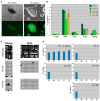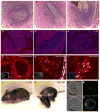Induced pluripotent stem cells generated without viral integration
- PMID: 18818365
- PMCID: PMC3987909
- DOI: 10.1126/science.1162494
Induced pluripotent stem cells generated without viral integration
Abstract
Pluripotent stem cells have been generated from mouse and human somatic cells by viral expression of the transcription factors Oct4, Sox2, Klf4, and c-Myc. A major limitation of this technology is the use of potentially harmful genome-integrating viruses. We generated mouse induced pluripotent stem (iPS) cells from fibroblasts and liver cells by using nonintegrating adenoviruses transiently expressing Oct4, Sox2, Klf4, and c-Myc. These adenoviral iPS (adeno-iPS) cells show DNA demethylation characteristic of reprogrammed cells, express endogenous pluripotency genes, form teratomas, and contribute to multiple tissues, including the germ line, in chimeric mice. Our results provide strong evidence that insertional mutagenesis is not required for in vitro reprogramming. Adenoviral reprogramming may provide an improved method for generating and studying patient-specific stem cells and for comparing embryonic stem cells and iPS cells.
Figures



Comment in
-
Induced pluripotent stem cells generated without viral integration.Hepatology. 2009 Mar;49(3):1048-9. doi: 10.1002/hep.22827. Hepatology. 2009. PMID: 19242974 No abstract available.
Similar articles
-
Adenoviral gene delivery can reprogram human fibroblasts to induced pluripotent stem cells.Stem Cells. 2009 Nov;27(11):2667-74. doi: 10.1002/stem.201. Stem Cells. 2009. PMID: 19697349
-
Generation of mouse induced pluripotent stem cells without viral vectors.Science. 2008 Nov 7;322(5903):949-53. doi: 10.1126/science.1164270. Epub 2008 Oct 9. Science. 2008. PMID: 18845712
-
Reprogramming adipose tissue-derived mesenchymal stem cells into pluripotent stem cells by a mutant adeno-associated viral vector.Hum Gene Ther Methods. 2014 Feb;25(1):72-82. doi: 10.1089/hgtb.2013.011. Epub 2013 Dec 28. Hum Gene Ther Methods. 2014. PMID: 24191859 Free PMC article.
-
Generation of clinically relevant "induced pluripotent stem" (iPS) cells.J Stem Cells. 2011;6(3):109-27. J Stem Cells. 2011. PMID: 23264997 Review.
-
Emerging methods for preparing iPS cells.Jpn J Clin Oncol. 2012 Sep;42(9):773-9. doi: 10.1093/jjco/hys108. Epub 2012 Jul 23. Jpn J Clin Oncol. 2012. PMID: 22826352 Review.
Cited by
-
Manipulating cell fate through reprogramming: approaches and applications.Development. 2024 Oct 1;151(19):dev203090. doi: 10.1242/dev.203090. Epub 2024 Sep 30. Development. 2024. PMID: 39348466 Review.
-
Polymers as Efficient Non-Viral Gene Delivery Vectors: The Role of the Chemical and Physical Architecture of Macromolecules.Polymers (Basel). 2024 Sep 18;16(18):2629. doi: 10.3390/polym16182629. Polymers (Basel). 2024. PMID: 39339093 Free PMC article. Review.
-
CHIR99021 and Brdu Are Critical in Chicken iPSC Reprogramming via Small-Molecule Screening.Genes (Basel). 2024 Sep 13;15(9):1206. doi: 10.3390/genes15091206. Genes (Basel). 2024. PMID: 39336797 Free PMC article.
-
Dopaminergic progenitors generated by small molecule approach survived, integrated, and promoted functional recovery in (6-OHDA) mouse model of Parkinson's disease.J Neurol Sci. 2024 Oct 15;465:123188. doi: 10.1016/j.jns.2024.123188. Epub 2024 Aug 20. J Neurol Sci. 2024. PMID: 39178824 Free PMC article.
-
Generation of induced pluripotent stem cells from the Asian bats.Int J Vet Sci Med. 2024 Aug 12;12(1):81-90. doi: 10.1080/23144599.2024.2384835. eCollection 2024. Int J Vet Sci Med. 2024. PMID: 39139714 Free PMC article.
References
Publication types
MeSH terms
Substances
Grants and funding
LinkOut - more resources
Full Text Sources
Other Literature Sources
Research Materials

